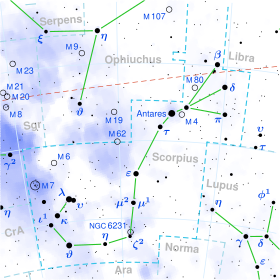| Observation data Epoch J2000.0 Equinox J2000.0 (ICRS) | |
|---|---|
| Constellation | Scorpius |
| Right ascension | 16h 53m 59.72713s[1] |
| Declination | −42° 21′ 43.3073″[1] |
| Apparent magnitude (V) | 4.705[2] (4.66 to 4.86)[3] |
| Characteristics | |
| Spectral type | B1.5 Iae[4] |
| U−B color index | −0.567[2] |
| B−V color index | +0.480[2] |
| Variable type | cLBV[5] |
| Astrometry | |
| Radial velocity (Rv) | −26.0[6] km/s |
| Proper motion (μ) | RA: −0.094 mas/yr[1] Dec.: −3.368 mas/yr[1] |
| Parallax (π) | 0.5855 ± 0.1176 mas[1] |
| Distance | approx. 6,000 ly (approx. 1,700 pc) |
| Absolute magnitude (MV) | −8.5[4] |
| Details | |
| Mass | 36 to 53[4] M☉ |
| Radius | 103 to 125.5[4] R☉ |
| Luminosity (bolometric) | 8.5×105 to 1.26×106[4] L☉ |
| Surface gravity (log g) | 1.7[4] cgs |
| Temperature | 17,200[4] K |
| Rotational velocity (v sin i) | 60[7] km/s |
| Age | 6.5 ± 0.1[8] Myr |
| Other designations | |
| Database references | |
| SIMBAD | data |


Zeta1 Scorpii (Zeta1 Sco, ζ1 Scorpii, ζ1 Sco) is a B-type hypergiant star in the constellation of Scorpius.[9] It has an apparent visual magnitude which varies between 4.66 and 4.86.[3] It is a member of the Scorpius OB1 association, and potentially of the open star cluster NGC 6231,[11] also known as the "Northern jewel box" cluster. Around 36 times as massive as the Sun, it is also one of the most luminous stars known in the Galaxy, with an estimated bolometric luminosity of around 850,000 times that of the Sun and a radius 103 times that of the Sun.[4]
The stellar wind from this supergiant is expelling matter from the star at the rate of 1.55 × 10−6 solar masses per year, or roughly the equivalent to the Sun's mass every 640,000 years.[4]
ζ1 Scorpii forms a naked eye double with ζ2 Scorpii, but the stars are merely coincidentally near in the line of sight from Earth. ζ2 is a mere 135 light-years distant and much less luminous in real terms. ζ1 Scorpii can also be distinguished from ζ2, due to the latter's orange hue especially in long-exposure photographs.
ζ1 Scorpii is a candidate luminous blue variable (cLBV), a star with the luminosity and spectral appearance of an LBV, but one that has not yet shown the characteristic types of variability.[5] It has been classified as dormant or ex-S Doradus variable, an older name for LBVs.[12]
- ^ a b c d Cite error: The named reference
GaiaDR3was invoked but never defined (see the help page). - ^ a b c Cite error: The named reference
aass61_387was invoked but never defined (see the help page). - ^ a b Cite error: The named reference
gcvs1was invoked but never defined (see the help page). - ^ a b c d e f g h i Clark, J. S.; Najarro, F.; Negueruela, I.; Ritchie, B. W.; Urbaneja, M. A.; Howarth, I. D. (2012). "On the nature of the galactic early-B hypergiants". Astronomy & Astrophysics. 541: A145. arXiv:1202.3991. Bibcode:2012A&A...541A.145C. doi:10.1051/0004-6361/201117472. S2CID 11978733.
- ^ a b Nazé, Y.; Rauw, G.; Hutsemékers, D. (2012). "The first X-ray survey of Galactic luminous blue variables". Astronomy & Astrophysics. 538: A47. arXiv:1111.6375. Bibcode:2012A&A...538A..47N. doi:10.1051/0004-6361/201118040. S2CID 43688343.
- ^ Cite error: The named reference
rgcrvwas invoked but never defined (see the help page). - ^ Cite error: The named reference
csrv70was invoked but never defined (see the help page). - ^ Cite error: The named reference
mnras410_1_190was invoked but never defined (see the help page). - ^ a b Cite error: The named reference
sb0was invoked but never defined (see the help page). - ^ Cite error: The named reference
Sterkenwas invoked but never defined (see the help page). - ^ Cite error: The named reference
kalerwas invoked but never defined (see the help page). - ^ Van Genderen, A. M. (2001). "S Doradus variables in the Galaxy and the Magellanic Clouds". Astronomy and Astrophysics. 366 (2): 508–531. Bibcode:2001A&A...366..508V. doi:10.1051/0004-6361:20000022.
